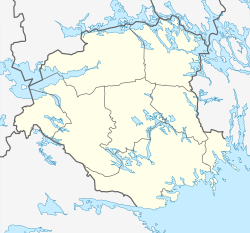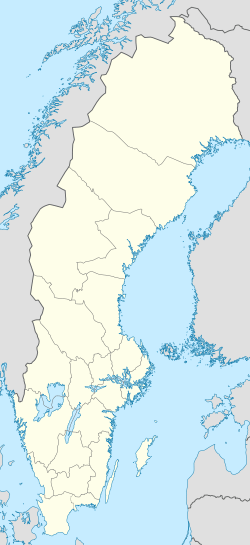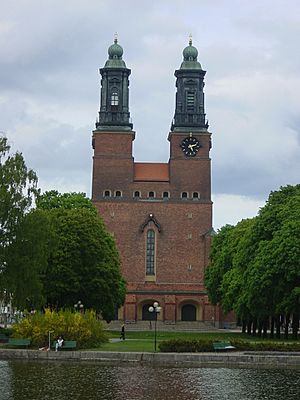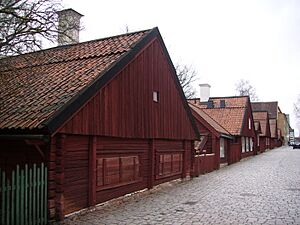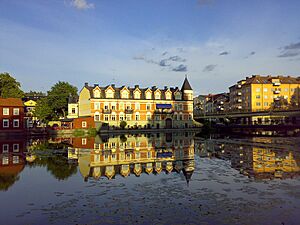Eskilstuna facts for kids
Quick facts for kids
Eskilstuna
|
|
|---|---|

Aerial photo of Eskilstuna in 2004
|
|
| Country | |
| Province | Södermanland |
| County | Södermanland County |
| Municipality | Eskilstuna Municipality |
| Founded | 1659 |
| Area | |
| • Total | 31.05 km2 (11.99 sq mi) |
| Elevation | 26 m (85 ft) |
| Population
(2020)
|
|
| • Total | 69 948 |
| • Density | 2,083/km2 (5,390/sq mi) |
| Time zone | UTC+1 (CET) |
| • Summer (DST) | UTC+2 (CEST) |
| Postal code |
630 03 to 638 21
|
| Area code(s) | (+46) 16 |
Eskilstuna is a city in Sweden. It is the main town of Eskilstuna Municipality in Södermanland County. In 2020, about 70,000 people lived in Eskilstuna city. The wider Eskilstuna municipality had over 107,000 residents in 2023. Many people from Finland live here. The city is built along the Eskilstunaån River, which connects two large lakes: Lake Hjälmaren and Lake Mälaren.
Contents
A Look Back at Eskilstuna's History
How Eskilstuna Began
Eskilstuna's story started a long time ago, in the Middle Ages. An English monk named Saint Eskil chose a place called "Tuna" as his home. He wanted to spread Christianity in the area. Sadly, he was killed by pagan vikings from a nearby town called Strängnäs. Saint Eskil was buried in his monastery church in Tuna.
Later, a Swedish king named Gustav Vasa destroyed Saint Eskil's monastery during the Protestant Reformation. This was a time when many religious changes happened in Europe. A royal castle, Eskilstuna House, was built in its place.
Becoming a City
Even though Strängnäs became an important religious center, Eskilstuna did not get its own city rights right away. This was because it was very close to the older town of Torshälla.
Eskilstuna finally became a city in 1659. This new city included the area of Tunafors and a new town called Karl Gustavs Stad. This new town was on the west side of the river.
The City of Karl Gustav
Karl Gustavs Stad was built around iron workshops run by a skilled smith named Reinhold Rademacher. King Karl X Gustav encouraged him to set up these workshops. At first, they made small arms and artillery (large guns).
From 1771, Karl Gustavs Stad became a "free town." This meant that craftspeople and factory owners could set up their businesses without paying taxes. This helped the town grow a lot. In 1879, Karl Gustavs Stad joined with the rest of Eskilstuna.
The Steel City
Eskilstuna grew very quickly during the Industrial Revolution. This was a time when many new factories and machines were invented. Eskilstuna became one of Sweden's most important industrial cities. It even earned the nickname "Stålstaden," which means "The City of Steel."
Besides firearms, the city also made excellent tools like chisels for woodworking, cutlery (knives and forks), scissors, keys, and special machines. To honor its steel industry, the city's official symbol (its coat of arms) includes a picture of a steel worker. Eskilstuna is sometimes called The Sheffield of Sweden, because both cities were famous for their steel production.
Eskilstuna's Economy Today
Eskilstuna is still an important industrial city. It is home to well-known companies like Volvo Wheel loaders, which makes heavy construction machines. Assa makes locks and keys, and Outokumpu makes Stainless steel.
The city also has a campus of Mälardalen University, which it shares with the city of Västerås. For fun, there's Parken Zoo, which is both a zoo and an amusement park. The Mälarsjukhuset hospital is one of the biggest in the area, with about 3,000 employees.
A Green Future
Since 2012, Eskilstuna has been working to become a "green city." This means they focus on protecting the environment. For example, their public buses run on biogas, a clean fuel. They also have special power plants that produce both heat and electricity.
Eskilstuna uses seven different recycling bins for sorting trash, which is more than the usual five in Sweden. They even have a special recycling center with a second-hand mall attached. You can drop off items to be recycled and then shop for used goods!
Climate in Eskilstuna
Eskilstuna has a climate that is a mix between continental and maritime. This means it has clear differences between seasons. Compared to areas closer to the coast, Eskilstuna often has bigger changes in temperature between day and night. It can also have stronger periods of very hot or very cold weather.
| Climate data for Eskilstuna (2002–2022 averages; extremes since 1961) | |||||||||||||
|---|---|---|---|---|---|---|---|---|---|---|---|---|---|
| Month | Jan | Feb | Mar | Apr | May | Jun | Jul | Aug | Sep | Oct | Nov | Dec | Year |
| Record high °C (°F) | 10.5 (50.9) |
12.2 (54.0) |
15.6 (60.1) |
26.1 (79.0) |
29.0 (84.2) |
32.0 (89.6) |
36.2 (97.2) |
35.1 (95.2) |
29.0 (84.2) |
21.5 (70.7) |
16.9 (62.4) |
11.3 (52.3) |
36.2 (97.2) |
| Mean maximum °C (°F) | 6.9 (44.4) |
7.5 (45.5) |
13.2 (55.8) |
19.2 (66.6) |
24.8 (76.6) |
27.9 (82.2) |
30.2 (86.4) |
28.3 (82.9) |
22.8 (73.0) |
16.1 (61.0) |
11.7 (53.1) |
7.4 (45.3) |
30.7 (87.3) |
| Mean daily maximum °C (°F) | 0.2 (32.4) |
1.2 (34.2) |
5.6 (42.1) |
11.7 (53.1) |
17.1 (62.8) |
21.3 (70.3) |
23.7 (74.7) |
22.2 (72.0) |
17.1 (62.8) |
10.3 (50.5) |
5.4 (41.7) |
1.7 (35.1) |
11.5 (52.6) |
| Daily mean °C (°F) | −2.8 (27.0) |
−2.3 (27.9) |
1.3 (34.3) |
5.8 (42.4) |
11.0 (51.8) |
15.2 (59.4) |
17.7 (63.9) |
16.6 (61.9) |
12.1 (53.8) |
6.6 (43.9) |
2.8 (37.0) |
−1.2 (29.8) |
6.9 (44.4) |
| Mean daily minimum °C (°F) | −5.7 (21.7) |
−5.5 (22.1) |
−3.1 (26.4) |
−0.2 (31.6) |
4.8 (40.6) |
9.1 (48.4) |
11.6 (52.9) |
10.6 (51.1) |
7.1 (44.8) |
2.8 (37.0) |
0.2 (32.4) |
−4.0 (24.8) |
2.3 (36.2) |
| Mean minimum °C (°F) | −19.0 (−2.2) |
−16.9 (1.6) |
−12.6 (9.3) |
−7.3 (18.9) |
−3.2 (26.2) |
2.3 (36.1) |
5.4 (41.7) |
3.4 (38.1) |
−1.1 (30.0) |
−5.7 (21.7) |
−9.2 (15.4) |
−16.2 (2.8) |
−21.7 (−7.1) |
| Record low °C (°F) | −29.5 (−21.1) |
−32.2 (−26.0) |
−23.8 (−10.8) |
−11.7 (10.9) |
−7.2 (19.0) |
−1.7 (28.9) |
2.9 (37.2) |
0.7 (33.3) |
−6.2 (20.8) |
−11.6 (11.1) |
−21.1 (−6.0) |
−32.2 (−26.0) |
−32.2 (−26.0) |
| Average precipitation mm (inches) | 40.2 (1.58) |
31.9 (1.26) |
23.7 (0.93) |
27.2 (1.07) |
44.7 (1.76) |
64.2 (2.53) |
62.3 (2.45) |
73.5 (2.89) |
40.4 (1.59) |
56.9 (2.24) |
48.0 (1.89) |
43.9 (1.73) |
556.9 (21.92) |
| Source 1: SMHI Open Data | |||||||||||||
| Source 2: SMHI Open Data | |||||||||||||
Population Growth in Eskilstuna
| 1800 | 1850 | 1900 | 1950 | 2000 | 2010 | |
|---|---|---|---|---|---|---|
| Inhabitants | 1 341 | 3 961 | 13 663 | 53 363 | 88 404 | 96 311 |
As of December 31, 2019, Eskilstuna Municipality had a population of 106,859 people. This makes it the 15th largest municipality in Sweden.
Sports in Eskilstuna
Eskilstuna is home to many sports teams.
Handball
The handball club Eskilstuna Guif plays in Sweden's top league. They have reached the Swedish Championship final four times but have not yet won.
Gliding
Eskilstuna is also home to EFK (Eskilstuna Flygklubb), which is Sweden's largest glider flying club. They even hosted the World Gliding Championships in 2006!
Football
Eskilstuna has had three men's football teams play in the highest league, Allsvenskan:
- IFK Eskilstuna (14 seasons)
- AFC Eskilstuna (2 seasons)
- Eskilstuna City (1 season)
The women's football team, Eskilstuna United DFF, plays in the Elitettan, which is the second-highest league. They played nine seasons in the top league, Damallsvenskan, between 2014 and 2022. In 2015, they finished second, which allowed them to play in the 2016–17 UEFA Women's Champions League.
Speedway
The speedway team in Eskilstuna is called Smederna. They race in Sweden's top speedway league, Elitserien. Their home races are held at Smedstadion just outside Eskilstuna.
eSports
In the world of eSports (competitive video gaming), Eskilstuna is the home of CS:GO player Maikelele.
The Tunavallen stadium in Eskilstuna was one of the places where games were played during the 1958 FIFA World Cup. It hosted a match between Paraguay and Yugoslavia. Many local football teams, including AFC Eskilstuna, Eskilstuna United DFF, Eskilstuna City FK, and IFK Eskilstuna, use Tunavallen as their home ground.
Getting Around Eskilstuna
Eskilstuna is connected by the Mälartåg railway line, which runs between Stockholm and Arboga. The major road European route E20 also passes through the city. Eskilstuna also has its own airport, located about 13 kilometers (8 miles) east of the city center.
European Cooperation
Eskilstuna is part of the Eurotowns network. This is a group of medium-sized cities across Europe that work together and share ideas.
Famous People from Eskilstuna
Music
- Hel (band)
- Kent (band)
- Pain of Salvation (band)
- Anni-Frid Lyngstad
- Mika "Gas" Ieppä
- Towa Carson
- Joakim Berg
- Daniel Gildenlöw
- Kristoffer Gildenlöw
Athletes
- Anna Nordqvist
- Kent Carlsson
- Kjell Johansson
- Tomas Gustafson
- Tommy Jansson
- Linnea Torstenson
- Kristján Andrésson
- Lars Sandberg
- Joel Granfors
Footballers
- Mika Väyrynen
- Kennet Andersson
- Sebastian Larsson
- Marcus Danielson
Other Notable People
- Anna Nordqvist, professional golfer
- Anna of Finland
- Carl Victor Heljestrand
- Fredrik Lindström
- Yvonne Ryding, Miss Sweden 1984 and Miss Universe 1984
- Susanne Aalto, radio astronomer
See also
 In Spanish: Eskilstuna para niños
In Spanish: Eskilstuna para niños


